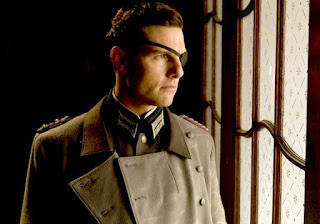Directed by Lloyd Bacon; produced by Robert Lord (associate
producer)
Francis Monroe Warren (Errol Flynn) has everything: a successful
and undemanding career as an investment broker, wealth, a large house,
servants, a pretty, loving wife (Brenda Marshall) to whom he’s devoted, even a
admiring mother-in-law. He also has a secret life. Most days, Warren leaves his
office and goes to a small suburban house where he writes mysteries under the
pseudonym of F X Pettijohn. His lives are about to become complicated, however,
with the death of a prospective client, and a criminal investigation in which
he tries to keep one step ahead of the police – and his newly suspicious
spouse.
After five consecutive period roles (seven, if one counts The Dawn Patrol), all dramas, Flynn chose
to star in this light-hearted comedy, set in contemporary times. Despite the
moderate response from audiences, he made a good choice: Footsteps in the Dark is, if not a hilarious side-splitter, a fun,
entertaining movie that shows Flynn could be amusing.
The story is a fairly typical movie mystery, with the murderer
rather easily spotted. There are plot-holes and incongruities – such as what
the victim (Noel Madison) knew when he insinuated blackmail against Warren –
and the clues and their results are no more than what might be found in the
average 1970s tv detective series. Nor are we told much about the characters.
It is not explained why Warren wrote his book – which makes liberal and
possibly libelous use of his mother-in-law’s ladies’ club – or where his money
came from (inheritance? His work?). Why a police inspector should take an
interest, however casual, in a death by heart-attack is unknown, as well.
The fun, however, isn’t really in solving the riddle or dissecting
characters, but in the actions and reactions of Flynn and other cast members.
Warren is portrayed as an easy-going gentleman who takes an even easier-going
approach to his job. His interaction with Inspector Mason (Alan Hale) of the
Homicide Bureau is a good one. How it started is a mystery in itself, though
it’s clear that despite the verbal barbs, they like each other. The chemistry
is probably reflective of Flynn and Hale’s relationship: the two collaborated
in at least half a dozen films.
Other characters are more stock. William Frawley is tiresome as a
truly dense copper though Allen Jenkins helps as Warren’s secretary and
chauffeur, and only confidante in his writing. Brenda Marshall has a bit of
depth as the wife; she worked with Flynn in 1935’s The Sea Hawk. Ralph Bellamy has little reason to show his skills in
his part as a dentist.
The writing is mediocre, with few memorable lines, though Mason’s
explanation of why a crime-writer might seem a successful detective, with his
already-solved mystery spread over three hundred pages of red herrings and
false suspects, is dead-on. Other than the previously mentioned plot-holes,
there are other head-scratchers. Turhan Bey has a small but interesting part as
the murder-victim’s servant, an Indian who respects gentlemen no matter their
race. He may have been included for a touch of exoticism, but disappears
half-way through the movie.
Then there is Lee Patrick as the loud and obvious burlesque queen
Blondie White. The movie is from an era which recognised the attractiveness of
Rita Hayworth, Betty Grable and Ava Gardner, so I had to wonder if the
professions of devotion from her male fans – and the pretence of love from
Warren (trying to prise information from Blondie) – were intended as a gag.
It is perhaps invidious to compare Footsteps in the Dark to something such as The Thin Man, despite a proposed series based on the former, in the
vein of the latter. The Thin Man, and
some of its sequels, were written by Tony- and Pulitzer-prize winners. Footsteps in the Dark’s script is not
witty or intelligent; this, combined with the unusual casting of Flynn, may
have hurt the film’s box office. Even so, the movie is an enjoyable hour and a
half, thanks to the lead and the happy-go-lucky atmosphere of the story.































